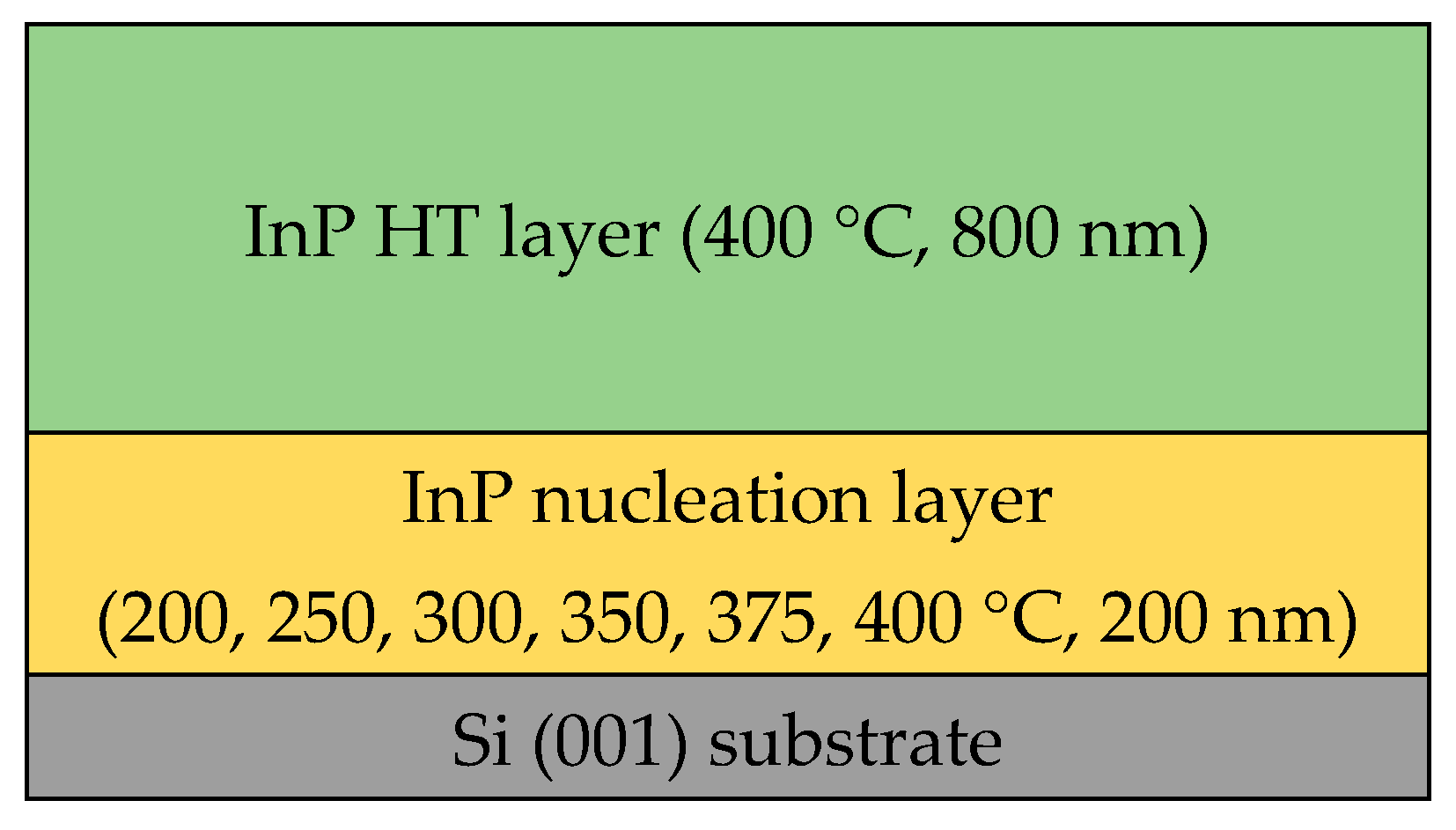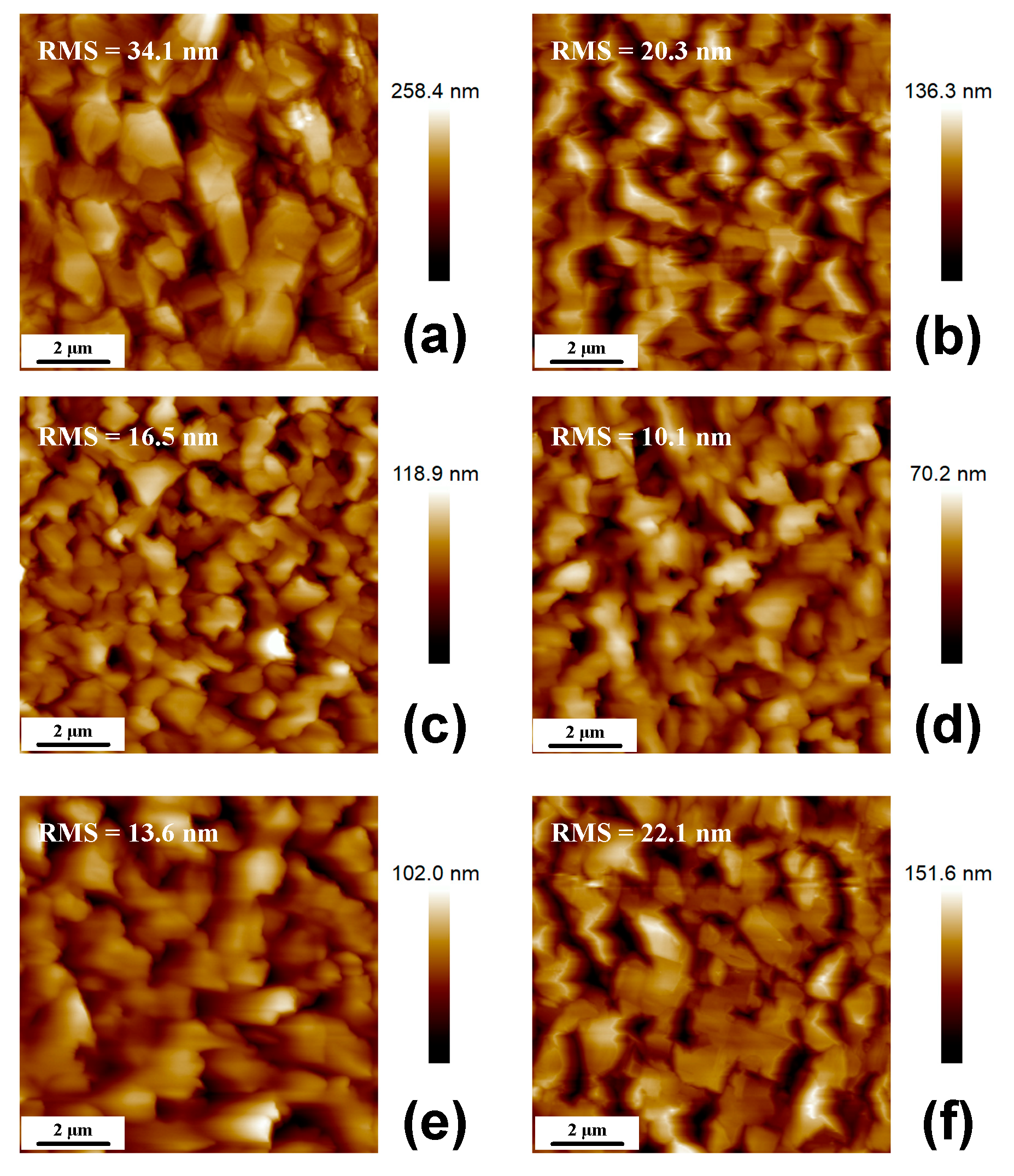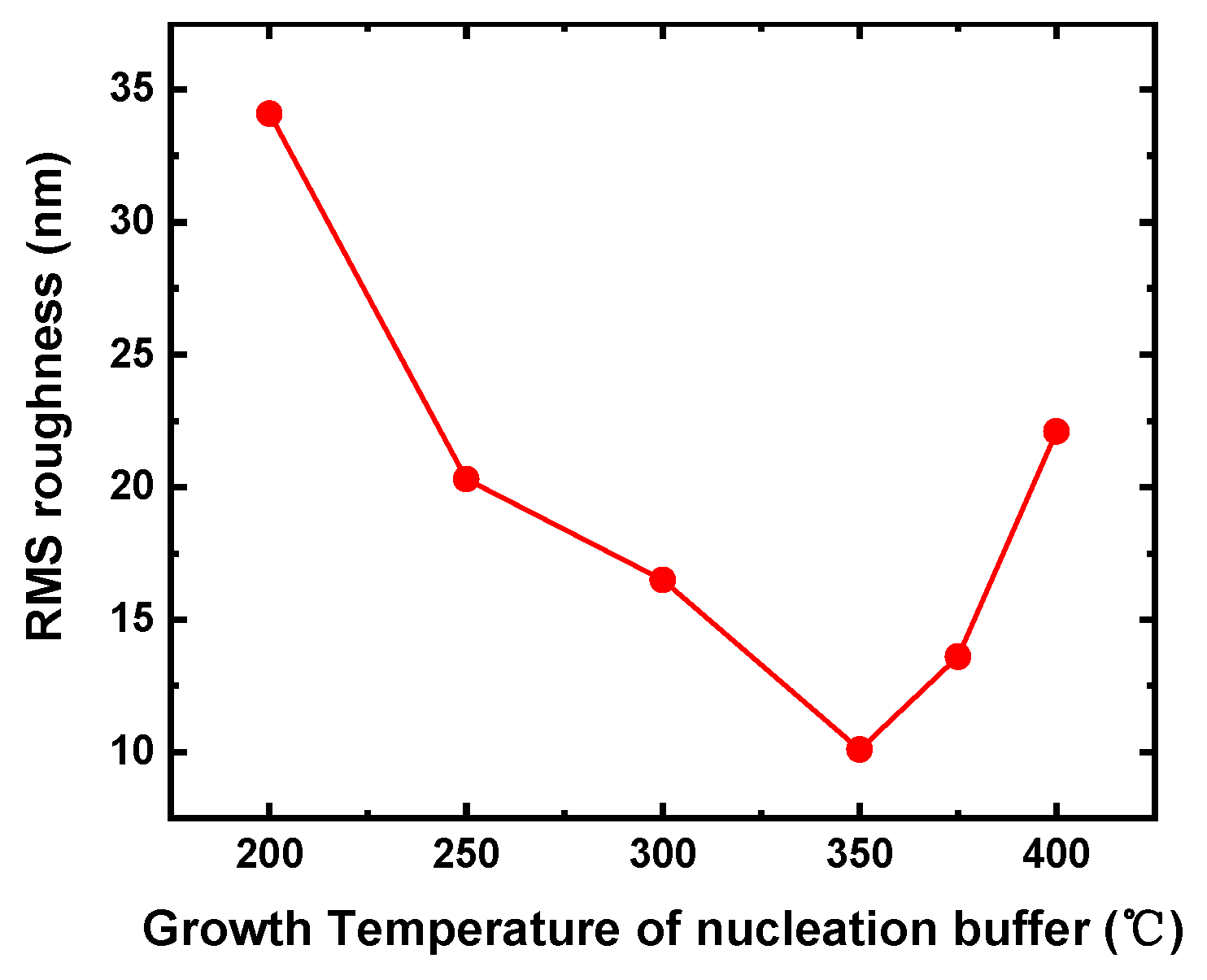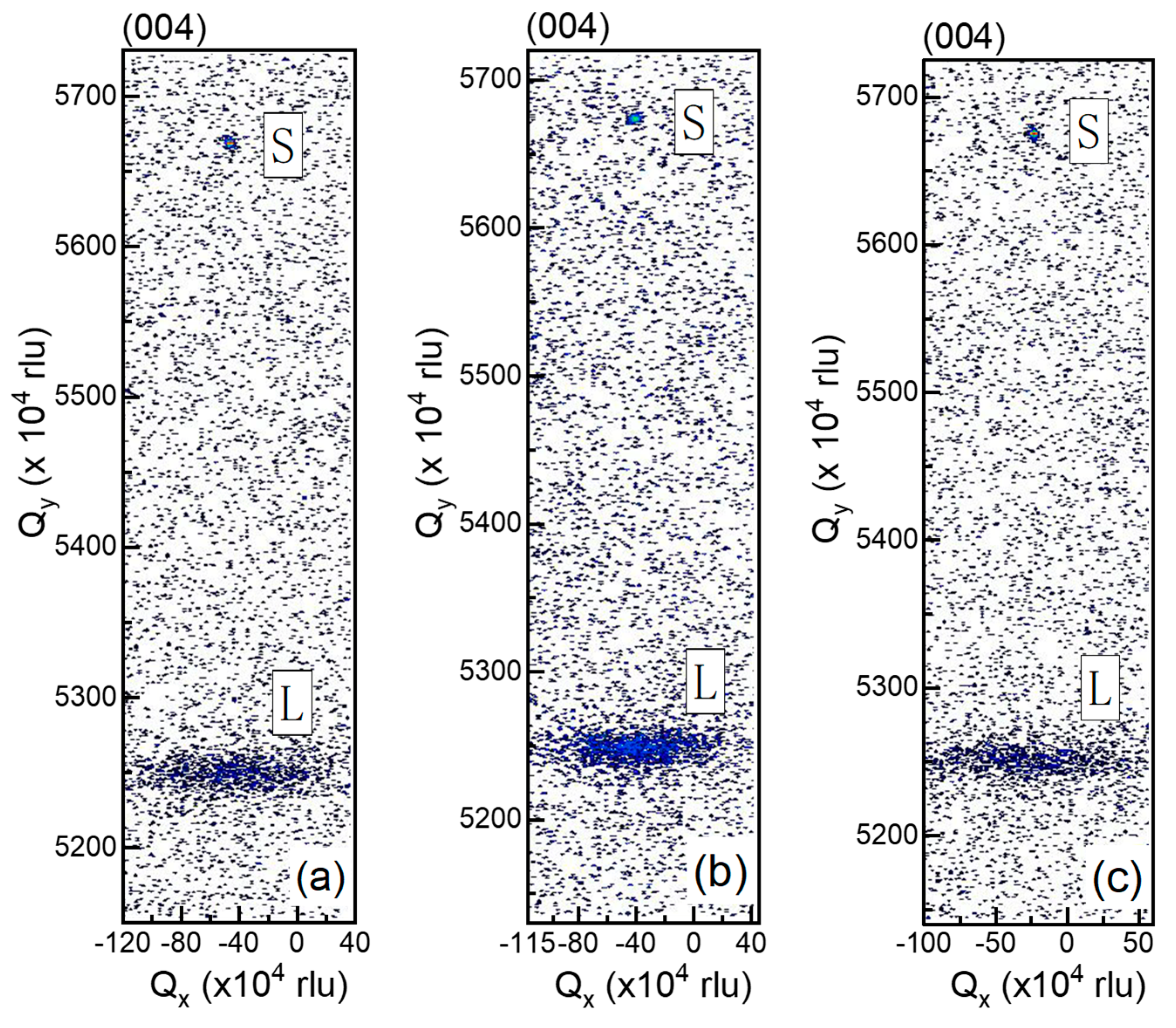Influence of Growth Temperature of the Nucleation Layer on the Growth of InP on Si (001)
Abstract
:1. Introduction
2. Experimental
3. Results and Discussion
3.1. Cross-Section and Surface Morphology
3.2. Crystal Structure
4. Conclusions
Author Contributions
Funding
Acknowledgments
Conflicts of Interest
References
- Hiraki, T.; Aihara, T.; Hasebe, K.; Fujiia, T.; Takedaa, K.; Nishia, H.; Kakitsukaa, T.; Fukudaa, H.; Tsuchizawaa, T.; Matsuoa, S. Heterogeneous Integration of III-V Semiconductors on Si Photonics Platform. ECS Trans. 2018, 86, 11–16. [Google Scholar] [CrossRef]
- Lourdudoss, S.; Junesand, C.; Kataria, H.; Metaferia, W.; Omanakuttan, G.; Sun, Y.T.; Wang, Z.C.; Olsson, F. Trends in heteroepitaxy of III-Vs on silicon for photonic and photovoltaic applications. In Proceedings of the Smart Photonic and Optoelectronic Integrated Circuits XIX, San Francisco, CA, USA, 20 February 2017. [Google Scholar]
- Li, Q.; Lau, K.M. Epitaxial growth of highly mismatched III-V materials on (001) silicon for electronics and optoelectronics. Prog. Cryst. Growth Charact. Mater. 2017, 63, 105–120. [Google Scholar] [CrossRef] [Green Version]
- Kumar, A.; Lee, S.Y.; Yadav, S.; Tan, K.H.; Loke, W.K.; Dong, Y.; Lee, K.; Wicaksono, S.; Liang, G.; Yoon, S.F.; et al. Integration of InGaAs MOSFETs and GaAs/AlGaAs lasers on Si Substrate for advanced opto-electronic integrated circuits (OEICs). Opt. Express 2017, 25, 31853–31862. [Google Scholar] [CrossRef] [PubMed]
- Loke, W.K.; Lee, K.H.; Wang, Y.; Tan, C.S.; Fitzgerald, E.A.; Yoon, S.F. MOCVD growth of InGaP/GaAs heterojunction bipolar transistors on 200 mm Si wafers for heterogeneous integration with Si CMOS. Semicond. Sci. Technol. 2018, 33, 115011. [Google Scholar] [CrossRef]
- Green, D.S.; Dohrman, C.L.; Demmin, J.; Zheng, Y.; Chang, T.H. A Revolution on the Horizon from DARPA: Heterogeneous Integration for Revolutionary Microwave/Millimeter-Wave Circuits at DARPA: Progress and Future Directions. IEEE Microwav. Mag. 2017, 18, 44–59. [Google Scholar] [CrossRef]
- Mei, X.; Yoshida, W.; Lange, M.; Lee, J.; Zhou, J.; Liu, P.H.; Leong, K.; Zamora, A.; Padilla, J.; Sarkozy, S.; et al. First demonstration of amplification at 1 THz using 25-nm InP high electron mobility transistor process. IEEE Electron Device Lett. 2015, 36, 327–329. [Google Scholar] [CrossRef]
- Weimann, N.G.; Johansen, T.K.; Stoppel, D.; Matalla, M.; Brahem, M.; Nosaeva, K.; Boppel, S.; Volkmer, N.; Ostermay, I.; Krozer, V.; et al. Transferred-Substrate InP/GaAsSb heterojunction bipolar transistor technology with fmax~0.53 THz. IEEE Trans. Electron Devices 2018, 65, 3704–3710. [Google Scholar] [CrossRef] [Green Version]
- Urteaga, M.; Carter, A.; Griffith, Z.; Pierson, R.; Bergman, J.; Arias, A.; Rowell, P.; Hacker, J.; Brar, B.; Rodwell, M.J.W. THz bandwidth InP HBT technologies and heterogeneous integration with Si CMOS. In Proceedings of the 2016 IEEE Bipolar/BiCMOS Circuits and Technology Meeting (BCTM), New Brunswick, NJ, USA, 25–27 September 2016. [Google Scholar]
- Kazior, T.E. Beyond CMOS: Heterogeneous integration of III-V devices, RF MEMS and other dissimilar materials/devices with Si CMOS to create intelligent microsystems. Philos. Trans. R. Soc. A Math. Phys. Eng. Sci. 2014, 372, 20130105. [Google Scholar] [CrossRef] [Green Version]
- Nguyen, X.S.; Yadav, S.; Lee, K.H.; Kohen, D.; Kumar, A.; Made, R.I.; Lee, K.E.K.; Chua, S.J.; Gong, X.; Fitzgerald, E.A. MOCVD Growth of High Quality InGaAs HEMT Layers on Large Scale Si Wafers for Heterogeneous Integration with Si CMOS. IEEE Trans. Semicond. Manuf. 2017, 30, 456–461. [Google Scholar] [CrossRef]
- Megalini, L.; Šuran Brunelli, S.; Charles, W.; Taylor, A.; Isaac, B.; Bowers, J.; Klamkin, J. Strain-Compensated InGaAsP Superlattices for Defect Reduction of InP Grown on Exact-Oriented (001) Patterned Si Substrates by Metal Organic Chemical Vapor Deposition. Materials 2018, 11, 337. [Google Scholar] [CrossRef] [Green Version]
- Tournié, E.; Cerutti, L.; Rodriguez, J.; Liu, H.; Wu, J.; Chen, S. Metamorphic III–V semiconductor lasers grown on silicon. MRS Bull. 2016, 41, 218–223. [Google Scholar] [CrossRef]
- Kunert, B.; Mols, Y.; Baryshniskova, M.; Waldron, N.; Schulze, A.; Langer, R. How to control defect formation in monolithic III/V hetero-epitaxy on (100) Si? A critical review on current approaches. Semicond. Sci. Technol. 2018, 33, 93002. [Google Scholar] [CrossRef]
- Merckling, C.; Jiang, S.; Liu, Z.; Waldron, N.; Boccardi, G.; Rooyackers, R.; Wang, Z.; Tian, B.; Pantouvaki, M.; Collaert, N.; et al. Monolithic Integration of III-V Semiconductors by Selective Area Growth on Si (001) Substrate: Epitaxy Challenges & Applications. ECS Trans. 2015, 66, 107–116. [Google Scholar]
- Li, S.; Zhou, X.; Kong, X.; Li, M.; Mi, J.; Pan, J. Catalyst-free growth of InP nanowires on patterned Si (001) substrate by using GaAs buffer layer. J. Cryst. Growth 2016, 440, 81–85. [Google Scholar] [CrossRef]
- Shi, B.; Li, Q.; Lau, K.M. Self-organized InAs/InAlGaAs quantum dots as dislocation filters for InP films on (001) Si. J. Cryst. Growth 2017, 464, 28–32. [Google Scholar] [CrossRef]
- Li, Q.; Tang, C.W.; Lau, K.M. Growth of ultra-high mobility In0.52Al0.48As/InxGa1-xAs (x > = 53%) quantum wells on Si substrates using InP/GaAs buffers by metalorganic chemical vapor deposition. Appl. Phys. Express 2014, 7, 045502. [Google Scholar] [CrossRef]
- Huang, M.L.; Chang, S.W.; Chen, M.K.; Fan, C.H.; Lin, H.T.; Lin, C.H.; Chu, R.L.; Lee, K.Y.; Khaderbad, M.A.; Chen, Z.C.; et al. In0.53Ga0.47As MOSFETs with high channel mobility and gate stack quality fabricated on 300 mm Si substrate. In Proceedings of the 2015 Symposium on VLSI Technology (VLSI Technology), Kyoto, Japan, 27 August 2015. [Google Scholar]
- Li, J.; Miao, G.; Zhang, Z.; Zeng, Y. Experiments and analysis of the two-step growth of InGaAs on GaAs substrate. CrystEngComm 2015, 17, 5808–5813. [Google Scholar] [CrossRef]
- Okumura, S.; Suzuki, R.; Tsunoda, K.; Nishino, H.; Sugiyama, M. Suppression of Three-Dimensional Pit Formation of InAs on GaSb (001) by Two-Step MBE. In Proceedings of the 2019 Compound Semiconductor Week (CSW), Nara, Japan, 19–23 May 2019. [Google Scholar]
- Shin, K.W.; Kim, H.; Kim, J.; Yang, C.; Lee, S.; Yoon, E. The effects of low temperature buffer layer on the growth of pure Ge on Si (001). Thin Solid Films 2010, 518, 6496–6499. [Google Scholar] [CrossRef]
- Barrett, C.S.C.; Martin, T.P.; Bao, X.Y.; Kennon, E.L.; Gutierrez, L.; Martin, P.; Sanchez, E.; Jones, K.S. Effect of bulk growth temperature on antiphase domain boundary annihilation rate in MOCVD-grown GaAs on Si(001). J. Cryst. Growth 2016, 450, 39–44. [Google Scholar] [CrossRef]
- Li, J.; Guo, Z.; Zhao, L.; Jia, Z.; Zhang, M.; Zhao, L. Effect of thicknesses of InP epilayers on InP/GaAs heterostructure. Surf. Interface Anal. 2018, 50, 27–31. [Google Scholar] [CrossRef]
- Cho, Y.; Lee, I.; Kim, S.; Jun, D.; Choi, I.; Kwon, H.; Shin, C.; Park, K.; Park, W.; Kim, D.; et al. Two-Step Growth of Epitaxial InP Layers by Metal Organic Chemical Vapor Deposition. J. Nanosci. Nanotechnol. 2016, 16, 5168–5172. [Google Scholar] [CrossRef] [PubMed]
- Lee, S.; Cho, Y.J.; Park, J.; Shin, K.W.; Hwang, E.; Lee, S.; Lee, M.; Cho, S.; Su Shin, D.; Park, J.; et al. Effects of growth temperature on surface morphology of InP grown on patterned Si(001) substrates. J. Cryst. Growth 2015, 416, 113–117. [Google Scholar] [CrossRef]
- Kwoen, J.; Jang, B.; Lee, J.; Kageyama, T.; Watanabe, K.; Arakawa, Y. All MBE grown InAs/GaAs quantum dot lasers on on-axis Si (001). Opt. Express 2018, 26, 11568. [Google Scholar] [CrossRef] [PubMed]
- Liu, A.Y.; Peters, J.; Huang, X.; Jung, D.; Norman, J.; Lee, M.L.; Gossard, A.C.; Bowers, J.E. Electrically pumped continuous-wave 1.3 μm quantum-dot lasers epitaxially grown on on-axis (001) GaP/Si. Opt. Lett. 2017, 42, 338–341. [Google Scholar] [CrossRef]
- Jung, D.; Callahan, P.G.; Shin, B.; Mukherjee, K.; Gossard, A.C.; Bowers, J.E. Low threading dislocation density GaAs growth on on-axis GaP/Si (001). J. Appl. Phys. 2017, 122, 225703. [Google Scholar] [CrossRef] [Green Version]
- Crumbaker, T.E.; Lee, H.Y.; Hafich, M.J.; Robinson, G.Y. Growth of InP on Si substrates by molecular beam epitaxy. Appl. Phys. Lett. 1989, 54, 140–142. [Google Scholar] [CrossRef]
- Ayers, J.E. The measurement of threading dislocation densities in semiconductor crystals by X-ray diffraction. J. Cryst. Growth 1994, 135, 71–77. [Google Scholar] [CrossRef]






| Sample | Intensity of 004 (a.u) | FWHM of 004 (arcsec) | Intensity of 115 (a.u) | FWHM of 115 (arcsec) |
|---|---|---|---|---|
| A | 44 | 1657.6 | 30 | 1806.82 |
| B | 128 | 1627.43 | 61 | 1619.11 |
| C | 355 | 1512.8 | 160 | 1464.3 |
| D | 495 | 1507.08 | 247 | 1236.85 |
| E | 283 | 1608.47 | 123 | 1427.2 |
| F | 208 | 1679.73 | 88 | 1639.5 |
© 2019 by the authors. Licensee MDPI, Basel, Switzerland. This article is an open access article distributed under the terms and conditions of the Creative Commons Attribution (CC BY) license (http://creativecommons.org/licenses/by/4.0/).
Share and Cite
Yang, S.; Lv, H.; Ai, L.; Tian, F.; Yan, S.; Zhang, Y. Influence of Growth Temperature of the Nucleation Layer on the Growth of InP on Si (001). Coatings 2019, 9, 823. https://doi.org/10.3390/coatings9120823
Yang S, Lv H, Ai L, Tian F, Yan S, Zhang Y. Influence of Growth Temperature of the Nucleation Layer on the Growth of InP on Si (001). Coatings. 2019; 9(12):823. https://doi.org/10.3390/coatings9120823
Chicago/Turabian StyleYang, Shizheng, Hongliang Lv, Likun Ai, Fangkun Tian, Silu Yan, and Yuming Zhang. 2019. "Influence of Growth Temperature of the Nucleation Layer on the Growth of InP on Si (001)" Coatings 9, no. 12: 823. https://doi.org/10.3390/coatings9120823





